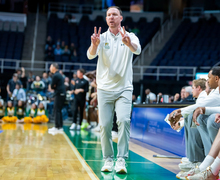Lakshmi Singh, other SU alums, discuss diversity in hiring
Sophia Faram | Staff Photographer
Lakshmi Singh is an anchor for National Public Radio.
NPR anchor and Syracuse University alumna Lakshmi Singh spoke about her experiences in the newsroom at the Joyce Hergenhan Auditorium on Tuesday night.
Singh told stories of encountering issues of diversity during her career and gave advice about being a young journalist of color. Singh graduated from SU in 1994 and triple majored in Latin American studies, Spanish and broadcast journalism in the S.I. Newhouse school of Public Communications and the College of Arts and Sciences.
Singh’s talk was part of the Race and the Media Symposium, a two-day event discussing diversity in the media industry.
At the start of the event, Associate Dean for Research, Creativity, International Initiatives and Diversity Hub Brown spoke about Newhouse Dean Lorraine Branham, who died earlier on Tuesday.
“Lorraine was a tireless advocate for the school,” Brown said. “We’re doing it because she’d want us to.”
A moment of silence for Branham was held at the start of the event.
Singh began by telling a story about a discussion she had with Branham about increasing diversity in Newhouse. Singh wanted to invest time in Newhouse, but she said she would not if the university did not commit to improving diversity.
“You talk the talk, but you’re not walking the walk,” Singh said
Singh then discussed NPR’s coverage of the controversy surrounding the protests at the Lincoln Memorial in Washington, D.C. in January, where a short video showed a student standing in the way of a Native American man during a rally. She said she recalled her colleagues carefully navigating the story.
Singh said this was a teachable moment in the newsroom, and that it is important to take time to thoroughly report on all aspects of larger, controversial stories.
“It is better to be right than first,” Singh said.
Singh talked about the coverage that NPR did on Hurricane Maria in Puerto Rico. She said she would frequently run into the issue of journalists at other publications calling Puerto Rican people “immigrants” when they are American citizens.
“A newsroom significantly diverse enough to reflect the communities it covers would catch that issue,” Singh said. “Newsrooms are far from adapting to those demographics. It’s not something that you can turn around in a month or in a year. It’s a process and we should’ve been starting 20, 30, 40 years ago.”
Five recent SU alumni joined Singh on the stage for a question and answer session. Brad Gorham, an associate professor of communications, asked if the panelists thought that white journalists were getting better at understanding their privilege.
Singh said she sees change in individuals who first acknowledge their biases and follow up with questions.
“There’s a tone of respect that must be employed, there’s a level of curiosity and interest that must be seen,” Singh said. “I think a lot of us don’t know what the conversation is supposed to sound like.”
Lena Pringle, an SU alum and morning anchor for WJXT in Jacksonville, Florida, said that if an individual does not personally face an issue, they will not realize that the issue exists. She said that though it is hard to fault people for things they do not know, it is a journalist’s job to constantly be broadening their horizons.
“You don’t have to personally be affected or understand something to be able to convey that,” Pringle said. “You can understand by having interviews and open conversations with people around you that (something) is an issue.”
Pringle said that newsrooms are moving forward with understanding privilege at a “very, very small pace.”
Senior Kelsey Davis asked about navigating the dynamic of self-advocacy in a newsroom.
Pringle told a story about the first month of her professional career, when she rose a concern about citing something in a broadcast. She said her boss proceeded to call her angry and told her to calm down.
“When we get mad, we look like angry black women,” Pringle said. “If you want to make it in this business, you’re going to have to learn when to raise your voice.”
Pringle said that the incident taught her about code switching, or changing how you act depending on the situation you are in. She said this was very challenging to learn as a young journalist.
Senior Divya Murthy asked for advice on how young journalists of color grapple with dealing with odds being stacked against them. Singh said it was a “harsh reality” that shrinking newsrooms lead to diversity not becoming a priority.
“Diversity is important, really important, when the newsroom is expanding,” Singh said. “When the newsroom has to shrink, we have found that consistently the issue of diversity falls lower on the list of priorities.”
Freshman Blessing Emole asked if diversity requirements in hiring are a step in the right direction.
Elliot Williams, an assistant editor at Washingtonian magazine, said that diversity as a hiring requirement does not hinder the credibility of a newsroom.
“I don’t think you could hire enough people of color to make up for all the time that we’ve been ignored,” Williams said.
The symposium continues on Wednesday at 9 a.m. with The Wall Street Journal data reporter Paul Overberg as the speaker. Following this, a panel of recent graduates will discuss their transition into the challenges and opportunities of covering diverse communities.
Published on April 2, 2019 at 11:37 pm
Contact Natalie: nrrubiol@syr.edu





